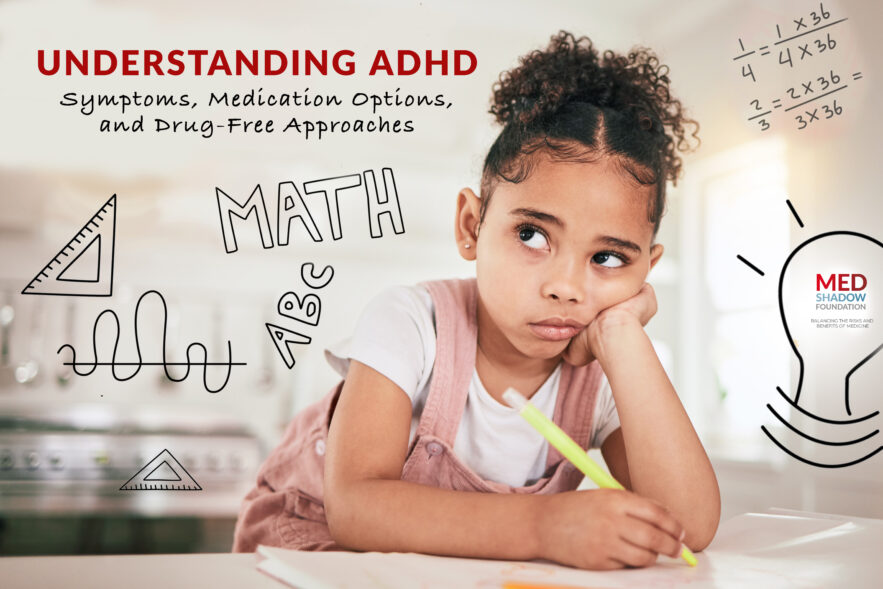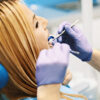Between 2020 and 2021, there was a large jump in the number of prescriptions doctors wrote for ADHD medications, according to the CDC. But even before 2020, prescriptions had been on the rise for nearly 10 years.
During the pandemic, our daily life changed dramatically and many of us may have struggled to keep up with tasks that may have been simpler within our structured routines. Telehealth companies, like Cerebral, rose to prominence promising quick access to ADHD diagnoses and medications from the comfort of your own home. Content creators on social media have grown followings by describing experiences that they attribute (sometimes accurately, sometimes inaccurately) to ADHD diagnoses. Lastly, women and adults, who previously went undiagnosed are receiving more care.
If you’ve found yourself wondering what you can do about ADHD, and have questions about the side effects of ADHD medications here’s what you need to know.
What is ADHD?
ADHD is a developmental disorder in which people have difficulty remaining focused, sitting still, and controlling impulsive behaviors. These characteristics can interfere with school, work, relationships, and organizing daily life. While it’s often diagnosed in childhood, the symptoms can last a lifetime, changing shape as the individual ages.
People with ADHD tend to have lower levels of two chemicals in the brain, norepinephrine and dopamine. These chemicals, which are types of neurotransmitters, help brain cells communicate with each other.
Types of ADHD
There are three subtypes of ADHD based on the types of symptoms the individual experiences and how those interfere with their life.
- Inattentive (ADHD-I)
- Hyperactive-Impulsive (ADHD-HI)
- Combined (ADHD-C)
ADHD Symptoms and How ADHD is Diagnosed
Diagnosis of ADHD changes slightly based on your age. If you are 16 or younger, and display six or more symptoms, you’ll be diagnosed with ADHD. If you’re over 17, it only takes five symptoms. The symptoms must be present for at least six months and interfere with your life in at least two different settings (such as home, work, school and social settings). The CDC specifies that the symptoms must be inappropriate for the individual’s developmental level. For example, difficulty organizing tasks and activities is probably age-appropriate behavior for a kindergartener, but less so for a 13-year-old.
A licensed healthcare provider, typically your general practitioner, psychologist or psychiatrist will make the diagnosis. They’ll ask you (or your child) a series of questions, and work to rule out any other diagnoses or side effects of medications that might cause ADHD-like symptoms. They have you complete cognitive tasks, and ask to speak to others in your life. For adults, this could include family members or partners while for children it might include parents or teachers.
Symptoms of ADHD-I include:
- Often fails to give close attention to details or makes careless mistakes in schoolwork, at work, or with other activities
- Often has trouble holding attention on tasks or play activities
- Often does not seem to listen when spoken to directly
- Often does not follow through on instructions and fails to finish schoolwork, chores, or duties in the workplace (e.g., loses focus, side-tracked)
- Often has trouble organizing tasks and activities
- Often avoids, dislikes, or is reluctant to do tasks that require mental effort over a long period of time (such as schoolwork or homework)
- Often loses things necessary for tasks and activities (e.g. school materials, pencils, books, tools, wallets, keys, paperwork, eyeglasses, mobile telephones).
- Is often easily distracted
- Is often forgetful in daily activities
Symptoms of ADHD-HI include:
- Often fidgets with or taps hands or feet, or squirms in their seat
- Often leaves the seat in situations when remaining seated is expected
- Often runs about or climbs in situations where it is not appropriate (adolescents or adults may be limited to feeling restless)
- Often unable to play or take part in leisure activities quietly
- Is often “on the go” acting as if “driven by a motor”
- Often talks excessively
- Often blurts out an answer before a question has been completed
- Often has trouble waiting their turn
- Often interrupts or intrudes on others (e.g., butts into conversations or games)
ADHD-C includes five or six symptoms from the ADHD-I list and five or six symptoms from the ADHD-HI list.
How Does ADHD Change with Age?
Some children do outgrow ADHD, or learn coping strategies that prevent it from interfering with their daily life. One study found that about 60% of symptoms continued into adulthood, but that as they grew up, they may have learned to manage those symptoms because only 41% had symptoms that continued impairing their lives.
Still, different symptoms may dominate at different points in your life. For example, children may seem more hyperactive and impulsive, whereas adolescents and adults may show more inattention.
What is Rejection Sensitive Dysphoria (RSD) with ADHD?
It’s important to note that ADHD doesn’t just impact an individual’s ability to work and learn at school. It can also interfere with their ability to regulate their emotions and maintain meaningful relationships.
Emotional regulation is your ability to monitor your emotions and adjust your responses to them to suit different situations and environments. Some research suggests that emotional dysregulation is a more definitive feature of ADHD in adulthood, despite the fact that children also struggle to regulate emotions. This is because all children, even those without ADHD, are still learning to regulate their emotions when they’re young, but as they get older, individuals with ADHD may continue to struggle while they’re unaffected counterparts don’t. For example, if a 3-year-old has a tantrum in the grocery store, it might be difficult to tell if that was normal developmental behavior or symptomatic of ADHD. However if an adult has a meltdown in a grocery store, it may be a clearer sign of a problem.
One example of emotional dysregulation that’s common in people with ADHD is rejection sensitive dysphoria (RSD). No one enjoys feeling left out or rejected, but a person with RSD will feel an extreme, overwhelming, and disproportionate amount of emotional pain if they feel like they are being criticized or rejected. Some might even feel physical pain like they’ve been punched. Someone with RSD might lash out in rage while others might feel so anxious in social situations that they start to avoid any settings in which they perceive a potential for rejection or failure.
RSD is common in individuals with ADHD, but you can experience it even without an ADHD diagnosis.
Causes of ADHD
Scientists don’t know exactly what causes ADHD. There does seem to be a strong genetic component, but environmental factors probably play a role, as well.
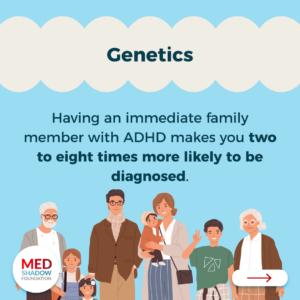
Traumatic brain injuries can cause ADHD, even once you’ve recovered. Studies have shown that ADHD-like symptoms occur frequently in children who were exposed to alcohol in utero.
Environmental factors such as a chaotic home or eating too much sugar do not cause ADHD, according to the CDC, but they may worsen symptoms in some cases. For example, having cell phones nearby makes it more likely that people will feel distracted, even if they aren’t using them.
Both children and adults have struggled with attention as the amount of time we spend looking at screens rises. This behavior can be mistaken for ADHD, or exacerbate existing ADHD. Read MedShadow’s ADHD in the Age of Smart Phones.
Is ADHD Hereditary?
Genes are thought to play a significant role in your risk of developing ADHD. If you have a parent or sibling with the condition, you are two to eight times more likely to receive the diagnosis than someone without an immediate family member with ADHD.
How To Treat ADHD Without Meds
There are many ways to manage ADHD throughout the lifetime, and in some cases, you can avoid the side effects of ADHD drugs completely. First, you’ll want to make sure that you or your child are maintaining healthy eating, exercise, and sleep habits. Problems in any of these areas can make it difficult to sustain energy and attention.
Then, if you’re an adult, consider MedShadow’s 18 Tips for Mastering Adult ADHD. The article includes tools, timers, and strategies like using a “body-double,” someone who sits quietly and works next to you, which can help you stay focused and motivated.
If you are the parent of a child with ADHD you can use strategies such as helping your child break down large tasks into smaller ones. For example, if you’re telling a child she needs to get ready for school, help her break that down and list the smaller tasks involved. First, she’ll need to brush her teeth, and then get dressed. Then she’ll need to eat breakfast. Then she’ll need to make sure her homework and lunch are in her backpack.
Cognitive Behavioral Therapy
A review of 14 trials suggests that cognitive behavioral therapy (CBT) can help alleviate ADHD symptoms and improve quality of life for adults, both when used with and without medication. CBT may also help children with organizational skills and managing emotions.
For children under 12 years old, experts recommend that parents participate in parent training for behavioral management, in which a therapist can help you implement strategies at home and in school to help your child practice better behavior, self control and self esteem.
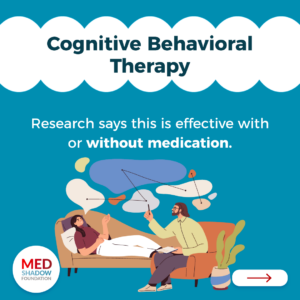
Aerobic Exercise
There is a lot of research out there on the benefits that exercise has for our brains. It can improve mental health, help stave off dementia, and even prevent cancer. Aerobic exercise in particular has been shown to help both children and adults with ADHD increase their attention spans.
Other studies have shown that exercise can help with executive function, such as attention, short term memory, and problem-solving, whether or not you have ADHD. And, it’s not just about tiring our bodies out so we don’t fidget; exercise releases chemicals in the brain like the dopamine that people with ADHD lack.
Binaural Beats and ADHD
There’s very little evidence that listening to binaural beats, two tones played at slightly different frequencies that can cause you to feel like there’s a third tone, while you work or study will actually help you focus, though one small study of just 20 kids suggests it might. Still, it’s unlikely to hurt with minimal side effects, and many on social media claim to find it helpful. You can find such beats on Spotify or YouTube to give it a try.
Tips for Helping Kids with ADHD
For more tips for helping your child manage ADHD, check out these MedShadow articles:
School Success for ADHD Students
5 Ways to Minimize Side Effects of Your Child’s ADHD Meds
Have an ADHD Kid? 5 Tips to Use Less Ritalin and More Parenting
Stimulant Medications for ADHD
The most commonly used medications for ADHD are stimulants. While there are many different brand names for stimulants such as Ritalin or Adderall, they all fall under two categories: methylphenidate-derived drugs and amphetamine-derived drugs. They both work by raising the levels of dopamine and norepinephrine in your brain.
Methylphenidate-derived drugs include:
- Ritalin
- Focalin
- Methylphenidate
- Methylin
- Adhansia XR
- Azstarys
- Aptensio
- Concerta
- Cotempla XR-ODT
- Daytrana
- Jornay PM
- Metadate
- Quilivant
Amphetamine-derived drugs include:
- Adderall
- Evekeo
- proCentra
- Zenzedi
- Adzenys
- Dexedrine Spansule
- Dyanavel
- Mydayis
- Vyvanse
- Guanfacine/Intuniv
- Clonidine/Kapvay
- Atomoxetine/Straterra
- Viloxazine/Qelbree
In 2021, a review of 24 studies found that extended-release methylphenidate stimulants did reduce symptoms of ADHD in adults, but that the improvements in quality of life were limited. The researchers stated that they couldn’t confidently say that the benefits were greater than the risks, especially because many of the studies they reviewed were designed in ways that made them likely to be biased, for example by including patients that had previously used similar drugs and had positive results.
Another important caveat they noted was, “there is also limited knowledge about the long-term effects of methylphenidate, which is often taken for years, since most trials lasted around eight weeks, and only one trial lasted for 52 weeks.” Researchers found similar results in an analysis of studies on children and adolescents.
Like methylphenidate-derived drugs, amphetamines are similarly effective in the short term (experts who researched both drugs emphasized the need for longer-term studies) but also led to substantial numbers of common side effects of ADHD drugs such as insomnia and nausea in both adults and children.
Side Effects of Ritalin, Adderall, and Other Stimulants for ADHD
More than half of people who take methylphenidate-derived stimulates for ADHD reported experiencing side effects, and one out of every 100 had severe side effects of the ADHD medications such as psychotic problems or cardiac issues.
People who were prescribed ADHD medications had a 1.4% higher risk of later being diagnosed with cardiovascular disease (13.5% compared to 11.9%) than those who weren’t prescribed ADHD medications, according to a study published in JAMA Psychiatry in November of 2023. The study included participants who were prescribed any type of ADHD drug approved in Sweden, but the three most commonly used drugs among the participants were two stimulants: methylphenidate (Daytrana, Quillivant XR, Cotempla XR-OTD), lisdexamfetamine (Vyvanse) and one non-stimulant: atomoxetine (Strattera). The study included patients from age 6-64, with a median age of 34.6 years old.
After three years of taking an ADHD drug, 13.4% of participants were diagnosed with arterial disease, compared to 12.2% who had not taken the drugs, and 15.4% were diagnosed with hypertension compared to 12.4% of controls. High blood pressure and arterial disease raise your risk for serious cardiovascular events such as heart attacks and strokes. The increase in risk of heart disease over 14 years of medication use was slightly higher for those that started taking the drug between the ages of 6 and 25, who had a 1.2% increase in risk, compared to those who started taking it after the age of 25, who had a 0.9% higher risk than those who did not take the drugs.
See MedShadow’s additional articles:
Possible Link Between ADHD Med and Psychotic Symptoms
Are We Overmedicating Our Youngest Kids with ADHD?
More common side effects of the ADHD medications methylphenidate and amphetamine-derived drugs included:
- Insomnia
- Decreased appetite
- Dry mouth
- Headaches
- Stomach aches
- A faster heart rate or palpitations
- Sweating
- Irritability
- Anxiety
According to patients who submitted stories on AskAPatient.com, stimulants like Adderall and Ritalin ranged from miracles to horror-story level mistakes. A 31-year-old woman wrote of Adderall “It’s an absolute godsend. For the first time in my life I’m a functional adult that can hold down a job and isn’t a depressed and anxious self-destructive mess.” But a 23-year old man, who started taking the drug at age 8, said he has suffered permanent heart damage as side effect of the ADHD medication. Many others describe insomnia, dry mouth and loss of appetite.
Modafinil (Provigil) Used Off-Label for ADHD
Modafinil is a drug typically prescribed to help people with narcolepsy stay awake. It works by raising the levels of several different neurotransmitters, including dopamine and noradrenaline. The FDA hasn’t approved it for use in ADHD. In fact, in 2006, the manufacturer applied for FDA approval, but it was blocked after at least one child in the clinical trials developed serious, blistering skin rashes, which could even have been deadly. Still, studies suggest it may help treat ADHD, particularly for people who don’t tolerate other stimulants well.
Side Effects of Modafinil
People who are prescribed modafinil often report headaches. To learn about modafinil headaches and what you can do to prevent them, read MedShadow’s A Modafinil Headache, Understanding the Side Effects of ‘Brain Drugs’ article.
Other side effects of modafinil include:
- Anxiety
- Nausea
- Nervousness
It’s also important to note that it’s possible to overdose on this drug. If you have diarrhea, confusion, tremors, chest pain, or heart palpitations, call your healthcare provider or emergency services.
Non-Stimulant Drugs for ADHD
If you and your healthcare provider decide you need medication, but stimulants don’t work or the side effects of those ADHD medications are unbearable, your provider might suggest a non-stimulant option. Several of these drugs were initially used for other conditions, such as depression, but work by increasing the availability of norepinephrine and/or dopamine in the brain.
Wellbutrin (Bupropion) for ADHD
Wellbutrin is an antidepressant, sometimes used off-label to treat ADHD. Researchers reviewed six clinical trials of the antidepressant for ADHD and found that it did reduce symptoms. However, the studies were relatively small; combined, the studies included a total of 438 participants. They were also short, lasting only six to 10 weeks. Still, the team concluded that the drug is an option for adults who need medicine but cannot or will not take stimulants for ADHD.
Side Effects of Wellbutrin can include:
- Headache
- Weight loss
- Dry Mouth
- Insomnia
- Nausea or stomach pain
- Dizziness
- Constipation
- Fast Heartbeat
- Sore Throat
- Rashes
- Anxiety
- Pain in your muscles or joints
- Seizures (particularly at higher doses)
- Hallucinations
- Suicidal ideations
Strattera (Atomoxetine)
Strattera makes more norepinephrine available in your brain. It’s less likely than stimulants to cause insomnia or other sleep disturbances in children, but it still has serious side effects.
This drug’s label contains a warning regarding the risk of suicidal thoughts and behaviors.
Side effects of the ADHD medication Strattera include:
- Dry mouth
- Difficulty sleeping
- Irritability
- Decreased appetite
- Weight loss
- Headaches
- Racing heartbeat.
- Constipation
- Sexual difficulties
- Dizziness
- Nausea
- Fatigue
- Sweating
Intuniv (guanfacine) for ADHD
This drug works by increasing levels of norepinephrine in parts of your brain that handle attention and cognition. Trials have suggested it may help treat ADHD in children and adolescents, used alone or in conjunction with stimulants. It is not approved for adults, though some may still be prescribed the drug off-label. It’s thought to help with emotional dysregulation.
Prior to being used for ADHD on its own, drugs like clonidine, a high blood pressure medication which uses the same mechanism, were used to enhance the effects of stimulants or to help those with ADHD sleep. While guanfacine will make you sleepy when you first start taking it, this usually wears off after two to three weeks of use.
Side effects of guanfacine include:
- Fatigue
- Rash
- Blurry vision
- Fainting
- Slowed heartbeat
- Low blood pressure
Qelbree (Viloxazine)
Qelbree (viloxazine), which was FDA-approved to treat ADHD in 2021, works by raising the levels of norepinephrine and another neurotransmitter, serotonin in the brain. Its approval was based on improvements seen in a six-week long trial, but in June 2023, researchers presented data at a conference suggesting that those benefits were sustained for a year.
This drug’s label contains a warning regarding the risk of suicidal thoughts and behaviors, a serious side effect of several ADHD drugs.
Other side effects of Qelbree include:
- Insomnia
- Fatigue
- Decreased appetite
- Headaches
- Nausea
Tricyclic Antidepressants
Like other ADHD medications, tricyclic antidepressants, such as amitriptyline and doxepin, raise levels of dopamine and norepinephrine in your brain. They do seem to improve symptoms of ADHD in children and adolescents, however, experts say they are not frequently used for ADHD because they come with serious safety risks such as heart problems.
Side Effects of Tricyclic Antidepressants Include:
- Dry mouth
- Blurry vision or Dizziness
- Constipation
- Difficulty urinating
- Drowsiness
- Weight gain
- Night sweats
- Arrhythmia (irregular heartbeats), palpitations, and rapid heart rate
Does Caffeine Help ADHD?
In a New York Times article about how parents and patients are coping with shortages of ADHD medication, one mother said, “We try to manage with a couple of caffeine drinks during the day and soccer in the afternoons.” She added that this has helped him regulate his emotions.
Researchers have found that limited doses of caffeine (one to two cups of coffee or tea) may help promote short-term memory function and concentration among adults with ADHD, but the stimulant hasn’t been studied thoroughly in children. Most of what we know about caffeine in ADHD is anecdotal, and it’s known to affect everyone a little differently. Caffeine works by blocking the effects of a neurotransmitter called adenosine that makes you start to feel sleepy. It does not directly increase levels of neurotransmitters like dopamine, but does enhance their impacts on the brain.
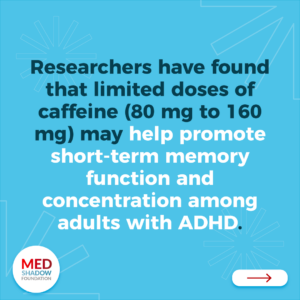
Having too much caffeine can negate the positive effects and cause side effects such as:
- Jitteriness
- Upset stomach
- Headaches
- Sleep disturbances
- Dependence
Supplements to Treat ADHD
Omega-3 Fatty Acids
These fats, commonly found in nuts, fatty fish, like salmon, and seeds are well known for having anti-inflammatory effects and myriad benefits for our health. A small study of boys in the Netherlands suggested that consuming 650 mg of omega-3s per day for 16 weeks increased their attention and improved their behavior. However, most of the boys in the study were already taking stimulant medications, as well. A larger analysis of several studies showed little evidence of improvement in ADHD symptoms with strictly omega-3 supplements.
Iron
Studies have suggested that children and adolescents with ADHD are more likely to have iron deficiencies than their neurotypical counterparts, and that iron deficiency worsened their symptoms. Iron plays a role in making dopamine in your brain.
Some foods high in iron include:
- Beef
- Spinach
- Beans
- Shellfish
Vitamin D
A review of four studies found that vitamin D supplements, used alongside stimulant medications, reduced ADHD symptoms, but the studies were not of high quality, according to the authors.
A Note of Caution for Any Supplement
Vitamins and supplements don’t get the same scrutiny from the FDA as drugs. The benefits and risks listed above are based on the assumption that your supplement contains exactly what is listed on the label, and nothing else. However, study after study has found that supplements can be tainted with pharmaceuticals or other contaminants that may cause additional side effects.
One way to reduce your risk is to check the label for a certification that the supplement has been tested by a third party. Groups like the National Science Foundation (NSF) or the United States Pharmacopeia (USP) test supplements to confirm that they contain the products listed on the label and don’t have unsafe levels of contaminants.
ADHD, Anxiety, and Depression
People with ADHD are at greater risk of being diagnosed with other mental illnesses or cognitive disorders such as learning disabilities, anxiety, and depression. About 11.5% of all children are diagnosed with any mental health condition or neurodevelopmental disorder, but 66.9% of children who are diagnosed with ADHD are diagnosed with another mental health condition or neurodevelopmental disorder.
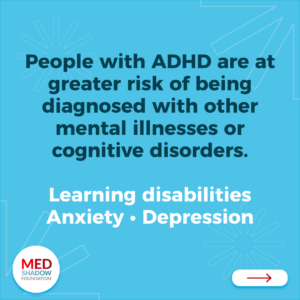
ADHD and Autism
Researchers are still working to understand the biological characteristics that ADHD and autism have in common, but scientists now estimate that 20 to 50% of people with ADHD may also meet the criteria for autism, and 30 to 80% of those diagnosed with autism meet the criteria for an ADHD diagnosis. It’s important to note that while many individuals have both ADHD and autism, they are not the same and ADHD is not considered part of the autism spectrum.


